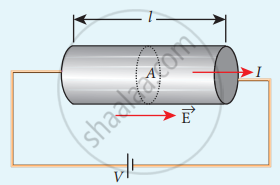Advertisements
Advertisements
Question
Obtain the macroscopic form of Ohm’s law from its microscopic form and discuss its limitation.
Solution
- Consider a segment of wire of length l and area of cross-section A
- Electric field is created when a potential difference V is applied
- If ‘E’ is uniform, then, V = El
- Current density, J = σ E = σ`"V"/l`
Since J = `"I"/"A"`
`"I"/"A" = sigma "V"/l`
Rearranging the above equation, Current through the conductor

Current through the conductor
V = `"I"(l/(sigma"A"))`
Where `(l/(sigma"A"))` → resistance of conductor (R)
∴ R `alpha (l/(sigma"A"))`
∴ The macroscopic form of Ohm's law is
V = IR ...[V α I]
Limitations:
There are certain materials and devices where the proportionality of V and I does not hold good.
APPEARS IN
RELATED QUESTIONS
Write the formula of resistivity
In an experiment of verification of Ohm’s law following observations are obtained.
|
Potential difference V (in volt) |
0.5 | 1.0 | 1.5 | 2.0 | 2.5 |
| current I (in ampere) | 0.2 | 0.4 | 0.6 | 0.8 | 1.0 |
Draw a V-I graph and use this graph to find:
- the potential difference V when the current I is 0.5 A,
- the current I when the potential difference V is 0.75 V,
- the resistance in a circuit.
A wire of resistance 9 ohm having length 30 cm is tripled on itself. What is its new resistance?
How would you connect two resistors in series? Draw a diagram. Calculate the total equivalent resistance.
State the relation correlating the electric current flowing in a conductor and the voltage applied across it. Also, draw a graph to show this. relationship.
A wire connected to a power supply of 230 V has power dissipation P1. Suppose the wire is cut into two equal pieces and connected parallel to the same power supply. In this case, power dissipation is P2. The ratio of `"P"_2/"P"_1` is
What is non ohmic device?
Define temperature coefficient of resistance.
Which of the following I-V graph represents ohmic conductors?
A student carries out an experiment and plots the V-I graph of three samples of nichrome wire with resistances R1, R2 and R3 respectively. Which of the following is hue?

